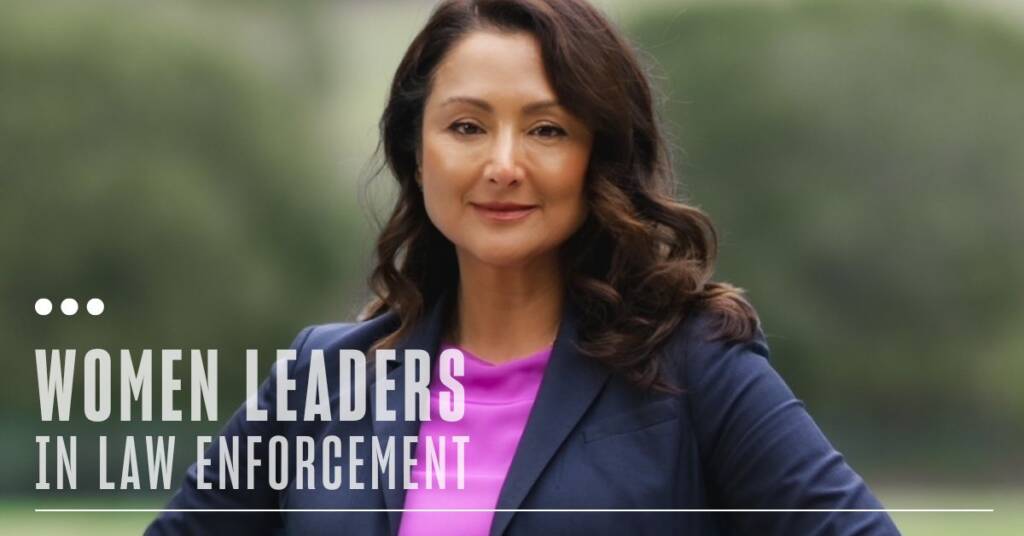This presentation was developed by a student in the M.S. in Law Enforcement & Public Safety Leadership program as part of the final capstone project. Through this video, Greg Galin, School Resource Officer from the Monterey (Calif.) Police Department demonstrates how developing a police department’s leadership techniques can inspire employees to engage with the community. The path-goal theory will be proposed as a model, with support from research on emotional intelligence.
As a police department it’s our job to not only make the community safe but to make the community members feel safe. How do we do this?
During the last 30 years, violent crime has significantly dropped in the United States. But according to The President’s Task Force on 21st Century Policing, the public’s level of confidence in police is the same today as it was 30 years ago. Why?
The Reactive Nature of Policing
Policing is a complex animal and has long been a reactive venture. A crime occurs, and police are called to investigate and suppress similar crimes from occurring in this area. In the meantime, events elsewhere are coming to a head and leading to more crime.
In this reactive cycle, the community perception is that the police are always one step behind. They lose confidence in us, and the police employees feel defeated and do not enjoy a sense of accomplishment (21st Century Policing Report, 2015).
Community policing is the means to break the cycle, raise public confidence, and make the community feel safer.
Turning Warriors Into Guardians
Currently a small group of employees are responsible for our police department’s community policing efforts. They are overwhelmed with the task of creating partnerships and solving the problems of our entire community. To be successful in community policing we will have to transform our organization.
We will ask every employee from the Chief of Police to the newest recruit to change their mindset from that of a warrior to that of guardians. As community guardians, we will engage with our fellow members of the community and build a relationship before crime takes place. These interactions will range from a simple greeting from a patrol officer on the street to formal meetings between our command staff, business associations, and neighborhood groups.
By including the community in building problem solving strategies we will develop better solutions, increase confidence from the community, and receive a more understanding response when there are failures.
According to the President’s Task Force on 21st Century Policing, if we establish a relationship with the community that is built on trust and cooperation, the city will see benefits such as improved public safety, social connectivity, and economic strength (21st Century Policing Report, 2015).
To achieve these goals we need our employees to take initiative to genuinely reach out to the community, listen to their concerns, and incorporate it into their work.
But how can we motivate our entire staff to reach out to the community in a sincere way that comes from the heart? A punitive approach would simply result in employees doing the bare minimum to avoid consequences.
The Path-Goal Theory
The answer is a top down leadership approach that removes any obstacles that may be preventing employees from participating in community policing. This leadership technique is known as the Path-Goal Theory.
Let’s take a closer look at this theory:
The path goal theory is based on the expectancy model of motivation which says that the amount of effort people put forward and their attitude is based on their expectancy of a positive and valuable outcome. A 1973 University of Michigan and Yale University study found that “expectancy attitudes were found to be significantly related to some measures of effort and performance”.
This is basically a fancy way of saying if people believe they will be successful they will put forth more effort and perform better.
So as a path-goal leader, our job is to make our followers feel supported and clear any obstacles that may block or slow their efforts. The path-goal leader understands that the follower has emotional needs as well as a need for monetary compensation for work.
The path-goal leader has four leadership styles at their disposal: directive, supportive, participative, and achievement-oriented.
- The directive style simply provides structure and involves the leader telling the followers what, when, and how to do the work.
- The supportive style ensures the follower’s well-being by tending to their individual needs and displaying concern for each employee (Alanis Business Academy, 2014; Nahavandi, 2015).
- The participative style brings all employees into the decision-making process. This increases buy-in and improves the end product.
- The achievement-oriented style establishes challenging goals and sets high expectations. In other words, this is where inspiration and intellectual stimulation come into play.
The path goal theory was put to a test by Indiana University researchers. They surveyed 1,161 employees in the health care environment to explore the relationship between the directive style, the supportive styles, performance, and job satisfaction. The results showed that the directive style was correlated with reduced performance and the supportive style led to increased job satisfaction (Szilagyi, Sims, 1974).
[youtube]inu0pkuaKTk[/youtube]
Applying the Path-Goal Theory
How does the leader know which of the path-goal theory techniques to use and when? The right technique at the right time will clear the path between the employee and the goal, but the wrong choice could put up a roadblock. The objective is to avoid duplicating factors that already exist in the environment.
For example, it would not be appropriate to use the directive style with a group of followers that are highly experienced and is performing at a high level. Directing these workers on how to do their job would likely irritate them and cause resentment.
If a group of followers is highly emotionally supportive of each other, the leader may find it unnecessary to use the supportive style.
To effectively apply the path-goal theory, the leader must evaluate each follower’s personality, experience, and environment when considering what blend of styles to use.
To make this analysis and effectively carry it out, a leader must: (Sadri 2012)
- Be in touch with their own emotions (Self-awareness)
- Be able to manage their own moods (Self-regulation)
- Be positive and optimistic (self-motivation)
- Be able to imagine what their followers are feeling (Empathy)
- Be able to communicate and build relationships (Social skills)
The measure of this combination of traits is known as Emotional Intelligence (EI). (Sadri, 2012).
High EI is an important part of being an effective leader and can be increased through training. (Goleman 2004)
It is important to realize that we are asking our employees to search out new and creative ways to genuinely reach out to the community. Let’s take a moment to analyze this situation using the path-goal theory.
- Our employees are highly trained and experienced. They work in an environment full of rules and regulations and the task is clearly defined.
- A path-goal leader would steer clear of the directive style and choose the achievement-oriented, supportive, and participative styles.
- As law enforcement leaders, we tend to prefer the directive style because it gives us more control.
- Paramilitary organizations such as law enforcement are likely to be dominated by high control leaders.
- The rigid command structure of our organization does not promote bold independent action outside of an emergency.
High-control organizations are slower to evolve and adapt compared to the private sector because the market forces that incentivize private business do not exist in government work. Political fallout and bureaucracy also act as disincentives to taking risk in law enforcement.
The high-control/low-risk approach is appropriate for many of our functions in law enforcement. When lives and constitutional rights are on the line, it’s appropriate to take a cautious approach.
However, to develop ourselves in the area of community policing we must realize the multifaceted nature of police work, and compartmentalize our tolerance for risk and desire for control. Tactical decisions in the midst of an emergency require a rigid command structure and cautious risk management. Community policing requires us to reach out to the community with open arms and ask for their help. Doing so requires additional risk tolerance and less control.
As an example, when Chief Gonzales of the National City Police Department wanted to develop a program to deploy public safety surveillance cameras, he formed a Chief’s Advisory Group made up of local neighborhood association leaders, business association leaders, faith-based leaders, and others (Gonzales, A 2017). Chief Gonzales assumed risk that the group would advise against his proposals and he relinquished control by interrupting the normal command structure by bringing community members into the decision-making process.
It is unlikely that Chief Gonzales would form a community advisory group to address an emergency tactical situation. However, in the realm of community engagement he chose to assume some risk and relinquish some control to the citizen advisory group. He built relationships and increased community trust, which paid off because what would normally be a highly controversial proposal was implemented with little resistance from the community (Gonzales, A 2017).
Summary
In summary, there are several steps we should take to invigorate our organization to partner with the community.
First and foremost, the executive leadership will set the tone for all the leaders in the department and inspire them to clear the path for their followers’ successes.
It is important to recognize that leadership can be learned. We should develop a training program for sergeants and lieutenants and bring in expert coaches if the department does not have adequate resources. These leadership coaches could put on group workshops and work one on one with the employees to develop their skills as path-goal leaders.
The department can also incorporate the qualities of the path-goal leader into the employee evaluation process, and utilize follower surveys to give leaders feedback on their performance.
When recruiting new employees, we should look for people displaying high emotional intelligence, which is critical to any leader’s success.
These investments in development would not only make our leaders more effective in their current assignments, it would prepare them for higher level management (Bass 1990).
We should also recognize that a different leadership style will be more effective for community policing than for our enforcement efforts.
References
Alanis Business Academy (2014) Episode 162: The Path-Goal Theory of Leadership. Retrieved from https://www.youtube.com/watch?v=pRSio5j3Iy4
Goleman, D. (2004) What makes a leader? Harvard Business Review 82, no. 1.
Gonzales, A. (2017) LEPS 520 Module 3 Presentation 1. University of San Diego.
Lawler, E. (1973) Expectancy Theory and Job Behavior. Organizational behavior and human performance 9, 482-503.
Nahavandi, A. (2015) The Art and Science of Leadership. Upper Saddle River, NJ: Pearson.
President’s Task Force on 21st Century Policing. 2015. Final Report of the President’s Task Force on 21st Century Policing. Washington, DC: Office of Community Oriented Policing Services.
Sadri, G. (2012). Emotional Intelligence and Leadership Development. Public Personnel Management, 41(3), 535-548.
Szilagyi, A. D., & Sims Jr., H. P. (1974). An Exploration of the Path-Goal Theory of Leadership in a Health Care Environment. Academy Of Management Journal, 17(4), 622-634. doi:10.2307/255642
Vroom, V. (1964) Work and Motivation. New York: Wiley





